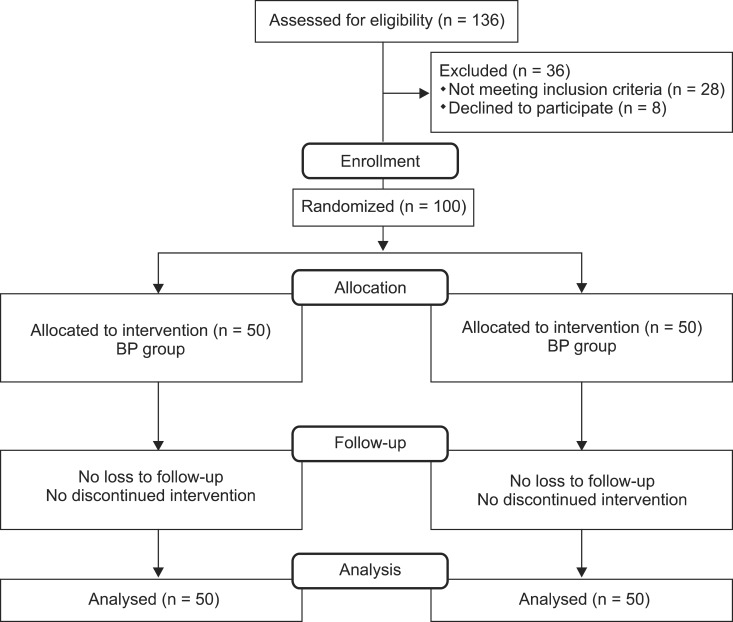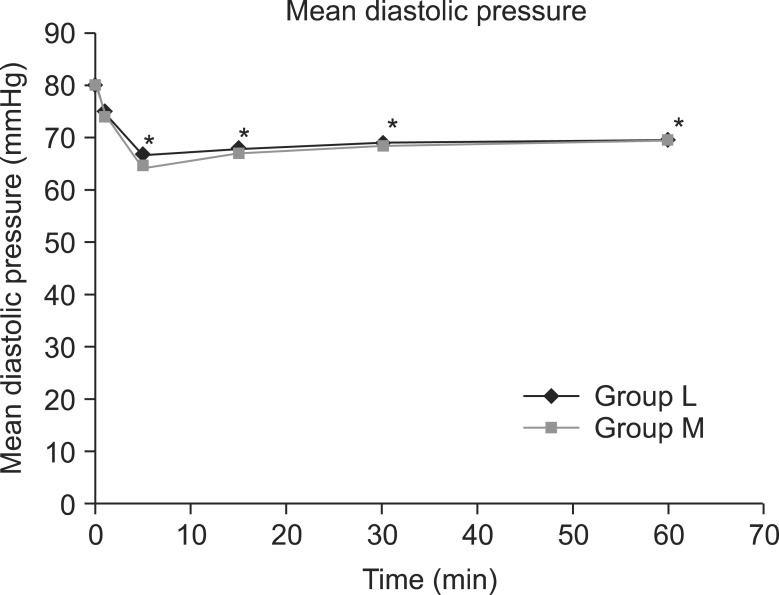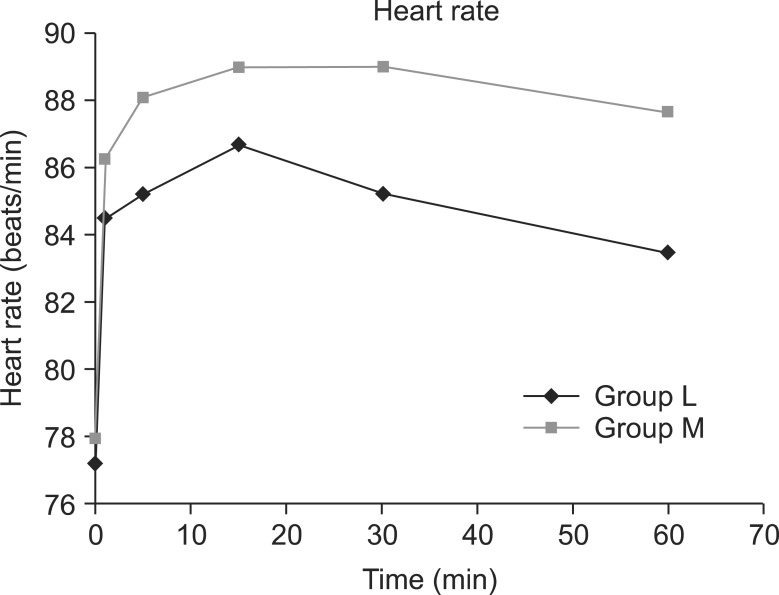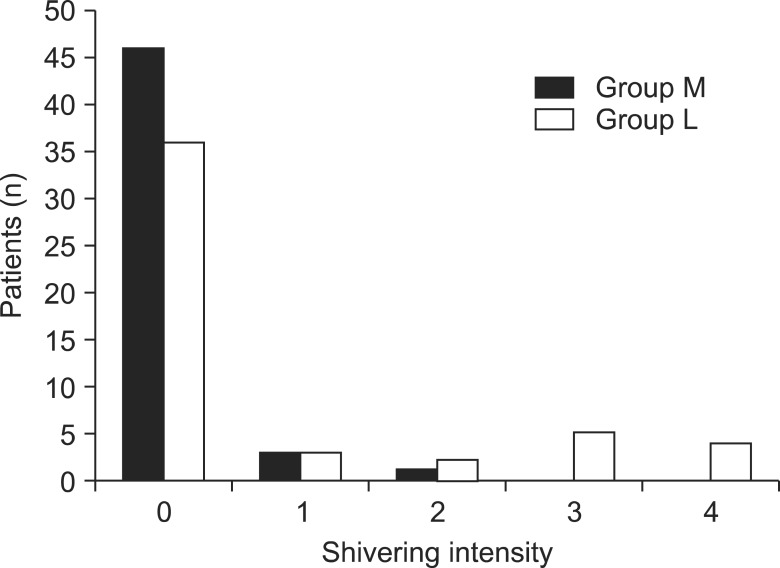Korean J Pain.
2013 Oct;26(4):379-386. 10.3344/kjp.2013.26.4.379.
Intrathecal Meperidine Plus Lidocaine for Prevention of Shivering during Cesarean Section
- Affiliations
-
- 1Department of Anaeasthesiology, Jahrom University of Medical Sciences, Jahrom, Iran.
- 2Department of Student Research Committee, Jahrom University of Medical Sciences, Jahrom, Iran. amin_m505@yahoo.com
- 3Department of Obstetrics and Gynecology, Shiraz University of Medical Sciences, Shiraz, Iran.
- KMID: 2074047
- DOI: http://doi.org/10.3344/kjp.2013.26.4.379
Abstract
- BACKGROUND
Shivering related to spinal anesthesia may interfere with monitoring and is uncomfortable. The aim of the present study was to investigate low-dose intrathecal meperidine for the prevention of shivering after induction of spinal anesthesia in parturients with cesarean section.
METHODS
This was a prospective randomized, double-blind, placebo-controlled trial including 100 parturients, of American Society of Anesthesiologists (ASA) physical status I or II, scheduled for elective cesarean section under spinal anesthesia who were randomly assigned to a meperidine (0.2 mg/kg) plus hyperbaric lidocaine (5%, 75 mg, n = 50; group M) group or a placebo plus hyperbaric lidocaine (5%, 75 mg, n = 50; group L) group. Demographic and surgical data, adverse events, and the mean intensity for each parturient were assessed during the entire study period by a blinded observer.
RESULTS
There were no significant differences between the two study groups regarding the demographic and surgical data (P > 0.05). The incidence of shivering during the entire study period significantly decreased in the group of parturients who received intrathecal meperidine (P = 0.04). There were no significant differences in nausea and vomiting between the two groups.
CONCLUSIONS
Low-dose intrathecal meperidine (10 mg) is safe and effective in reducing the incidence and severity of shivering associated with spinal anesthesia in parturients with cesarean section.
Keyword
MeSH Terms
Figure
Reference
-
1. Ciofolo MJ, Clergue F, Devilliers C, Ben Ammar M, Viars P. Changes in ventilation, oxygen uptake, and carbon dioxide output during recovery from isoflurane anesthesia. Anesthesiology. 1989; 70:737–741. PMID: 2497661.
Article2. Kurz A, Sessler DI, Schroeder M, Kurz M. Thermoregulatory response thresholds during spinal anesthesia. Anesth Analg. 1993; 77:721–726. PMID: 8214655.
Article3. Han SY, Jin HC, Yang WD, Lee JH, Cho SH, Chae WS, et al. The effect of low-dose ketamine on post-caesarean delivery analgesia after spinal anesthesia. Korean J Pain. 2013; 26:270–276. PMID: 23862001.
Article4. Matsukawa T, Sessler DI, Christensen R, Ozaki M, Schroeder M. Heat flow and distribution during epidural anesthesia. Anesthesiology. 1995; 83:961–967. PMID: 7486181.
Article5. Lee C, Choi DH, Chae SU. Circadian effects on neural blockade of intrathecal hyperbaric bupivacaine. Korean J Pain. 2010; 23:186–189. PMID: 20830264.
Article6. Crowley LJ, Buggy DJ. Shivering and neuraxial anesthesia. Reg Anesth Pain Med. 2008; 33:241–252. PMID: 18433676.
Article7. Han JW, Kang HS, Choi SK, Park SJ, Park HJ, Lim TH. Comparison of the effects of intrathecal fentanyl and meperidine on shivering after cesarean delivery under spinal anesthesia. Korean J Anesthesiol. 2007; 52:657–662.
Article8. Alfonsi P, Hongnat JM, Lebrault C, Chauvin M. The effects of pethidine, fentanyl and lignocaine on postanaesthetic shivering. Anaesthesia. 1995; 50:214–217. PMID: 7717486.
Article9. Alfonsi P, Sessler DI, Du Manoir B, Levron JC, Le Moing JP, Chauvin M. The effects of meperidine and sufentanil on the shivering threshold in postoperative patients. Anesthesiology. 1998; 89:43–48. PMID: 9667292.
Article10. Kurz M, Belani KG, Sessler DI, Kurz A, Larson MD, Schroeder M, et al. Naloxone, meperidine, and shivering. Anesthesiology. 1993; 79:1193–1201. PMID: 8267194.
Article11. Delaunay L, Bonnet F, Liu N, Beydon L, Catoire P, Sessler DI. Clonidine comparably decreases the thermoregulatory thresholds for vasoconstriction and shivering in humans. Anesthesiology. 1993; 79:470–474. PMID: 8363071.
Article12. Fukuda K. Intravenous opioid anesthetics. In : Miller RD, editor. Miller's anesthesia. 6th ed. New York (NY): Elsevier Churchill Livingstone;2005. p. 379–438.13. Casey WF, Smith CE, Katz JM, O'Loughlin K, Weeks SK. Intravenous meperidine for control of shivering during caesarean section under epidural anaesthesia. Can J Anaesth. 1988; 35:128–133. PMID: 3356050.
Article14. Chen JC, Hsu SW, Hu LH, Hong YJ, Tsai PS, Lin TC, et al. Intrathecal meperidine attenuates shivering induced by spinal anesthesia. Ma Zui Xue Za Zhi. 1993; 31:19–24. PMID: 7968324.15. Roy JD, Girard M, Drolet P. Intrathecal meperidine decreases shivering during cesarean delivery under spinal anesthesia. Anesth Analg. 2004; 98:230–234. PMID: 14693625.
Article16. Hong JY, Lee IH. Comparison of the effects of intrathecal morphine and pethidine on shivering after Caesarean delivery under combined-spinal epidural anaesthesia. Anaesthesia. 2005; 60:1168–1172. PMID: 16288613.
Article17. Khan ZH, Zanjani AP, Makarem J, Samadi S. Antishivering effects of two different doses of intrathecal meperidine in caesarean section: a prospective randomised blinded study. Eur J Anaesthesiol. 2011; 28:202–206. PMID: 21325901.
Article18. Crossley AW, Mahajan RP. The intensity of postoperative shivering is unrelated to axillary temperature. Anaesthesia. 1994; 49:205–207. PMID: 8147511.
Article19. Horn EP, Schroeder F, Wilhelm S, Sessler DI, Standl T, von dem Busche K, et al. Postoperative pain facilitates nonthermoregulatory tremor. Anesthesiology. 1999; 91:979–984. PMID: 10519500.
Article20. Mahajan RP, Grover VK, Sharma SL, Singh H. Intraocular pressure changes during muscular hyperactivity after general anesthesia. Anesthesiology. 1987; 66:419–421. PMID: 3826703.
Article21. de Courcy JG. Artefactual 'hypotension' from shivering. Anaesthesia. 1989; 44:787–788. PMID: 2802137.
Article22. Barker SJ, Shah NK. The effects of motion on the performance of pulse oximeters in volunteers (revised publication). Anesthesiology. 1997; 86:101–108. PMID: 9009945.
Article23. Just B, Delva E, Camus Y, Lienhart A. Oxygen uptake during recovery following naloxone. Relationship with intraoperative heat loss. Anesthesiology. 1992; 76:60–64. PMID: 1729937.
Article24. Jones HD, McLaren CA. Posoperative shvering and hypoxaemia after halothane, nitrous oxide and oxygen anaesthesia. Br J Anaesth. 1965; 37:35–41. PMID: 14254043.
Article25. Pflug AE, Aasheim GM, Foster C, Martin RW. Prevention of post-anaesthesia shivering. Can Anaesth Soc J. 1978; 25:43–49. PMID: 624105.
Article26. Entezari Asl M, Isazadehfar K, Akhavanakbari G, Khoshbaten M. The effect of ondansetron in prevention of postoperative shivering after general anesthesia in gynecological surgery. Iran Red Crescent Med J. 2012; 14:316–317. PMID: 22829994.27. Shoar S, Esmaeili S, Khorgami Z, Naderan M, Shoar N. Efficacy of acupuncture in prevention of postoperative anaesthesia-related shivering. Acupunct Med. 2013; 31:120–121. PMID: 23291356.
Article28. Horn EP, Werner C, Sessler DI, Steinfath M, Schulte am Esch J. Late intraoperative clonidine administration prevents postanesthetic shivering after total intravenous or volatile anesthesia. Anesth Analg. 1997; 84:613–617. PMID: 9052312.
Article29. Stoelting RK, Hillier SC. Pharmacology & physiology in anesthetic practice. 4th ed. Philadelphia (PA): Lippincott Williams & Wilkins;2006. p. 864.
- Full Text Links
- Actions
-
Cited
- CITED
-
- Close
- Share
- Similar articles
-
- Comparison of the Effects of Intrathecal Fentanyl and Meperidine on Shivering after Cesarean Delivery under Spinal Anesthesia
- Effect of Meperidine Spinal Anesthesia for Cesarean Section
- Intrathecal meperidine as the sole agent for cesarean section
- Effects of Intrathecal Meperidine on Prevention of Shivering during Spinal Anesthesia for Herniorrhaphy
- The relationship of preoperative anxiety with failure of extension of epidural analgesia for cesarean section







